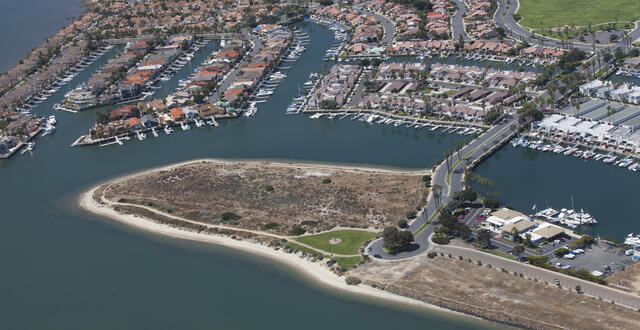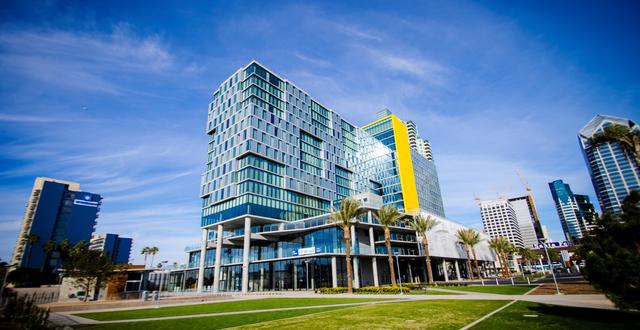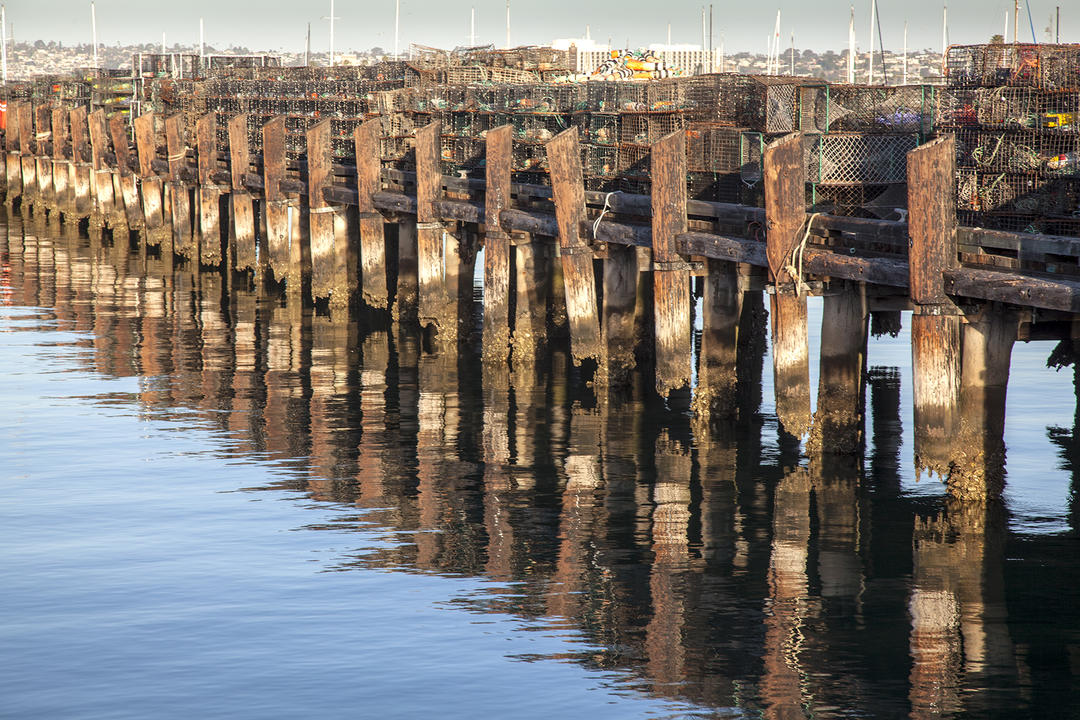Meeting Environmental Goals
The Environmental Conservation Department works with internal Port staff, as well as tenants, consultants and additional stakeholders to ensure multi-agency permit compliance on a wide range of projects in and around the bay. Environmental Conservation staff regularly coordinate with ACOE and RWQCB staff on various ranging from redevelopment to restoration in order to protect and enhance natural resources that may be impacted. Staff provide guidance on sustainable design efforts throughout a project’s timeline, including preliminary design discussions, construction best management practices, and long-term maintenance and avoidance measures.
As an environmental steward, the Port actively pursues and oversees restoration efforts within and around the Bay to improve upon and enhance ecosystem health. In December 2008, the Port of San Diego received a $1,000,000 grant from the U.S. EPA for the restoration of Emory Cove and the Chula Vista Wildlife Reserve (CVWR). The District matched the EPA grant with $1,200,000 in funding from the Port’s Environmental Fund. In partnership with the California Coastal Conservancy and the USFWS Refuge Division, the Port received additional grant funding from the USFWS and the American Reinvestment and Recovery Act of 2009, of which approximately $300,000 was awarded to the Port. This funding has assisted in the restoration and enhancement of over 280 acres of valuable habitat within San Diego Bay, including native plant restoration at Emory Cove and the creation and enhancement of the Chula Vista Wildlife Reserve.
Tijuana River Valley Pollution Crisis
Over 100 billion gallons of untreated sewage, toxic chemicals, trash, sediment, and other pollutants have flowed into the Tijuana River Valley and out into the Pacific Ocean off the coast of Imperial Beach. This is causing serious public health issues from polluted waters and airborne toxins, ongoing beach closures in Imperial Beach and Coronado, and negative impacts on the South Bay economy. Contaminated flows are directed through treatment plants under the jurisdictions of the U.S. and Mexico federal governments. However, these facilities have failing and aging infrastructure. The U.S. International Boundary and Water Commission (IBWC) operates the South Bay International Wastewater Treatment Plant (SBIWTP), and additional funding is needed to improve and expand the plant. Under Minute 328, Mexico is to replace the broken Punta Bandera Treatment Plant in Tijuana at the San Antonio de los Buenos Creek.
The Port of San Diego regularly collaborates with its partners to advocate for federal funding and legislative action, participates with other federal, state and regional stakeholders in the federal Eligible Public Entities Coordinating Group (EPECG) led by the U.S. Environmental Protection Agency (EPA), and supports recent air monitoring efforts in the South Bay by the San Diego County Air Pollution Control District (APCD). In solidarity with coordinated regional efforts, the Port of San Diego declared a local emergency in March 2024. The declaration follows similar actions by the cities of Imperial Beach and San Diego, and the County of San Diego. Click on the links below for additional information.
City of Imperial Beach
Imperial Beach Sewage Emergency
San Diego Regional Water Quality Control Board
Sewage Pollution Within the Tijuana River Watershed
Recovery Team
Advance Restoration Plan
EPA
USMCA Tijuana River Watershed
Stakeholder Engagement (EPECG)
USIBWC
Web Portal for Minute 328 Projects
Citizens Forum Meetings and Presentations
Scripps Institute of Oceanography
Cross Border Pollution
Integrated Natural Resource Management Plan (INRMP)
In September of 2000, the Port and the US Navy Southwest Division jointly prepared the Integrated Natural Resource Management Plan (INRMP) for San Diego Bay. This plan is a guide to assist the users of the Bay to make better, more cost-effective decisions about the development, conservation, restoration and management of San Diego Bay. The management plan also catalogues the plant and animal species around the bay and identifies habitat types. The plan was awarded the 2001 Partnership Award by Coastal America and an updated version of the plan is in development.
In 2007, the Port and the U.S. Navy embarked on an update to the INRMP. The management plan was revised and edited by a technical advisory committed. The committee consisted of different agencies and non-governmental organizations including the Regional Water Quality Control Board, Fish and Wildlife Services, National Marine Fisheries Service, Army Corps of Engineers, U.S. National Park Service, Fish and Game, Audubon Society, State Lands Commission and California Coastal Commission.
The INRMP was completed in 2013 and the final document is available for review in the “Reference Documents” link above.
Chula Vista Bayfront Natural Resources Management Plan (CVBNRMP)
The 500-plus acre Chula Vista Bayfront Master Plan project is recognized as one of the last great development opportunities to create a legacy destination for the public on San Diego Bay. The vision for the Chula Vista Bayfront is to sustain habitats and ecosystems that protect and nourish both native resident and migratory fish and wildlife, especially those that are at risk and dependent on the south bay. Once completed, the bayfront will be a destination for visitors as well as local residents and will reflect strong planning and design principles addressing sustainability of resources, economic feasibility and community benefit. The Chula Vista Bayfront Natural Resources Management Plan (CVBNRMP) serves as a critical environmental guidance and implementation document applicable to all development within the future Chula Vista Bayfront Master Plan scope. All future development projects within this area will be evaluated relative to furthering the goals, objectives, standards and strategies contained in the CVBNRMP.
The CVBNRMP was completed in 2016 and the final document is available for review in the “Reference Documents” link above.
Mitigation Banking
The Port is analyzing the potential development of a wetlands mitigation bank via the restoration of 83.5 acres of a 95-acre vacant former salt pond parcel (Pond 20) located in the southernmost portion of San Diego Bay. The project site historically supported wetland habitats until the salt evaporation and extraction industry began operations in South San Diego Bay in the late 1800s. While the salt ponds are still in operation in the southern portion of San Diego Bay, Pond 20 has not been utilized as an evaporation pond since the 1960s.
The proposed development of Pond 20 as a wetlands mitigation bank is one of many ways the Port is ensuring San Diego remains a vibrant resource and contributes to a healthy and sustainable waterfront for visitors and residents. The proposed Pond 20 wetlands mitigation bank development project is a collaborative effort between the Port, the cities of Imperial Beach and San Diego, stakeholders and planning groups. Funds from the proposed mitigation banking on Pond 20 will go into a Pond 20 Economic Development fund established for Board-approved economic development and public improvement projects in the adjacent communities within the cities of Imperial Beach and San Diego. The proposed mitigation bank is an example of how the Port champions the safekeeping and environmental care of our diverse ecosystems. Self-funded, the Port reinvests the revenues it collects from hundreds of waterfront businesses, and unique endeavors like the proposed Pond 20 wetlands mitigation bank, back into our communities and local economy.
Click here for additional information on Pond 20 wetlands mitigation bank
Advisory Committees and Groups
Environmental Advisory Committee (EAC): The Port’s Environmental Advisory Committee advises the Board on programs, policies, and projects that ensure the protection and improvement of the environmental conditions of San Diego Bay and surrounding tidelands. The EAC is composed of a member of the Board of Port Commissioners and representatives of stakeholder groups including Port tenants, environmental advocacy groups, the U.S. Navy, regulatory and resource agencies, member cities, academia, local business and labor. This diverse membership allows input from a broad and balanced cross section of the community. EAC meetings intend to encourage input from stakeholders and interaction with Port staff and Board members. EAC meetings are open to the public.
Wildlife Advisory Group (WAG): The Wildlife Advisory Group is an advisory group for the Chula Vista Bayfront redevelopment project that provides environmental guidance and feedback. The WAG is primarily responsible for preparation of a Natural Resources Management Plan for the Chula Vista Bayfront, which provides environmental guidance that goes above and beyond those required by federal, state and local laws and regulations. WAG meetings are open to the public.
What's Happening at the Port?

Waterfront Development
The National City Bayfront is made up of 273 acres of waterfront land and 167 acres of water and includes the National City Marine Terminal, Pepper Park, Pier 32 Marina, the Aquatic Center and many pieces of valuable public art. The National City…

One of the Port of San Diego's 23 parks, Grand Caribe Shoreline Park is located near the Coronado Cays neighborhood on an artificial peninsula in southwestern San Diego Bay. At 2.4 acres, it provides recreational public access to the coastline. Since…

Waterfront Development
Lane Field honors the treasured history of America's favorite pastime in San Diego and welcomes local residents and visitors from across the globe. Home to the Pacific Coast League Padres from 1936 to 1957, Lane Field is named after Bill Lane, the…
